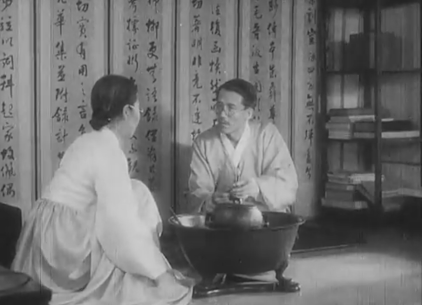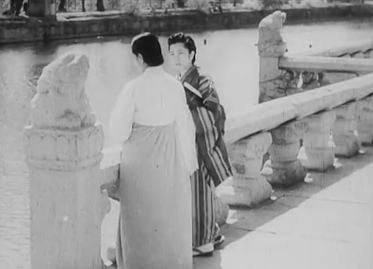This article from 1943 covers the severe wartime housing crisis in Korea which was particularly acute in urban areas and industrial hubs. The article blames the housing shortage on various factors, including rapid urban population growth, expansion of industries, increasing incomes, and rent control policies hindering investment in rental housing. From 1939-1941, while the number of new households increased annually by 57,627, there was a stark deficit in the number of new housing units, with only 18,000 units added each year, leading to a yearly shortfall of around 20,000 units. Major cities, including Seoul, Pyongyang, Busan, and Chongjin, experienced significant housing deficits. This led to many social problems, including young people unable to marry and start families. Due to overcrowding, workers sought respite outside the home, which is why movie theaters had an outsized importance in this era for workers seeking an escape from their miserable reality.
Just as many young people today in Mainland China lament their inability to purchase homes, which poses a barrier to marriage, Korean youths apparently faced similar predicaments eight decades ago, during the final years of Imperial Japanese colonial rule.
(Translation)
Gyeongseong Ilbo (Keijo Nippo), September 29, 1943
Three households in one house
Laborers have no homes to rest in
The War Lifestyle Reader Series: Housing (Part 1)
The words "house for rent" were written in black letters on a white piece of paper pasted messily on a lattice door of a residential home. Who has not seen such signs before? But now it has become a dream of the distant past. You have found someone to marry, but you don't have a house. You have been transferred to another city, but you can't go there because you can't find a house. It is no exaggeration to say that you will always be able to find three or four advertisements in the daily newspaper saying "Seeking a house for rent" or "No questions asked about the rent". Even a casual greeting to an acquaintance in passing would turn into a whine of, "By the way, do you know where I can find a house?" Indeed, the housing crisis is a serious concern shared by citizens of all belligerent nations of the world. So what is the relationship between war and housing, and how is it being resolved?
 |
| Original caption: "House for Rent" - that too has now become a dream of the distant past. |
WARTIME HOUSING PROBLEMS
To sum up, similar to the previously discussed matters of "clothing" and "food," the issue of health and hygiene is of equal importance in guaranteeing a basic standard of living for our fighting nation. In today's age, when productive capacity directly correlates with war fighting potential, the ongoing housing crisis affecting ordinary people and the productivity of laborers is just as critical as food security, not merely a social issue as it was perceived in the past. Moreover, if we look at postwar population strategies through the lens of national development via population growth, we can argue that the barriers to population increase, such as challenges related to marriage, separate living, dormitories, and room rental, represent a substantial national issue, if not a concern for our co-prosperity sphere. So, what are the measures taken during wartime to address housing? But before diving into that, it's important to understand: why did the war result in such a severe housing crisis?
TWO TYPES OF HOUSING DIFFICULTIES
In essence, we can categorize housing difficulties into two distinct types. The first involves an imbalance between supply and demand due to fluctuating prices, a phenomenon that was common during past recessionary periods. The second type is an outright shortage of housing relative to demand, a situation we typically see during wartime. However, does this imply that Korea's wartime population grew so swiftly that we couldn't build enough housing to accommodate everyone? Not exactly. The housing shortage was prominent not in rural areas, but primarily in cities, mines, factories, and other hubs. This circumstance arose from a combination of factors brought on by the war:
- Rapid population growth in urban areas was spurred by the expansion of government offices, companies, and other enterprises.
- The sudden rise of the military iron and steel industry led to an increase in production, which caused workers in these industries to quickly flock to these sites.
- The increase in income of these industrial workers inevitably led to them seeking to establish their own homes, rather than continuing to share houses or rent rooms as they did before.
- Conversely, the soaring cost of land, difficulty in obtaining construction materials such as steel, the lack of construction workers, and the cessation of land rent control led to a halt in investment in rental housing, culminating in a significant housing shortage.
WE NEED TO BUILD 88,000 HOUSING UNITS PER YEAR
Assessing the current situation on the Korean peninsula through a numerical lens, the average yearly increase of new households and net gain in housing units (accounting for both new constructions and demolitions) across all major Korean cities between 1939 and 1941 was 57,627 households and 17,999 housing units, respectively. Intriguingly, while the number of households has been increasing steadily year after year, the availability of housing units has been on the decline, which was particularly noticeable in 1940. It's easy to conjecture that this trend has likely become even more pronounced since then. Notably, the new households include cohabiting living arrangements, apartments, and dormitories, so not all of them would need new housing. However, based on the ratio of housing units to households, which was 63% according to the 1938 survey, the annual requirement for housing units can be calculated to be around 38,000. This number is considerably higher than the aforementioned 17,999 units provided, leading to an annual deficit of about 20,000 housing units. As of the end of 1941, the housing shortages across all of Korea, according to a survey conducted by the Governor-General's Office in the previous October, are as follows:
- Seoul: 41,333 housing unit deficit
- Pyongyang: 5,559 housing unit deficit
- Busan: 9,041 housing unit deficit
- Chongjin: 8,472 housing unit deficit
The total number of households in the 38 provinces and towns in all of Korea is over 106,000. Many of them have families but are forced to rent rooms, live in dormitories, or live separately from their families. The reality is that two or three households often have no choice but to share one house. According to a survey conducted by the Governor-General's Office, the following is a summary of the current situation.
| City | Renting Rooms | Sharing Houses | Single-household Houses |
|---|---|---|---|
| Seoul | 33% | 17% | 50% |
| Busan | 20.8% | 7.2% | 72% |
| Pyongyang | 31% | 9% | 60% |
| Hamhung | 12.3% | 11% | 76.6% |
| Chongjin | 9.3% | 9.1% | 81.6% |
(Note: Figures are rounded down to the nearest 0.0%.)
In other words, in the above five cities, 68% of the respondents lived in a house occupied by a single household, 21% rented rooms, and 11% shared their homes with other households.
NO RESTING PLACES FOR LABORERS
Therefore, homes to which workers return after a bustling day at work or after arduous manual labor during wartime have ceased to be sanctuaries of rest and relaxation. Instead, people seek respite outside the home. Entertainment districts teem with activity throughout the day, and movie theaters are marked by lengthy queues from morning till night. This kind of scene, which seems so out of sync with the times, may indeed warrant condemnation. However, it's only fair to say that those living in lavish mansions and comfortable official residences, who have never faced a housing crisis in their lives, should not be the ones to pass judgment or criticize such individuals.
Source: https://www.archive.org/details/kjnp-1943-09-29
(Transcription)
京城日報 1943年9月29日
一戸に三世帯の割
労務者に憩いの家なし
戦争生活読本 住の巻(上)
しもたや風の格子戸に雑に貼られた白い紙に、黒く書かれた『貸家』の文字。嘗てそれを散見しなかった人があろうか。だが、今はもう、それは遠い過去の夢だ。結婚の相手は決まったがサテ家がない。転勤にはなったが家がなくて赴任出来ぬ。日々の新聞の広告欄に『求貸家』、『不問家賃』の三つ四つ見られぬことは絶対ないといって過言でない。偶々往来で出遭った知人との挨拶も『ところで何処か家はないでしょうか』との泣き言に変わって来る始末。まことに住宅難こそは、世界の凡ゆる交戦国国民にとって共通する深刻な悩みである。然らば戦争と住宅。それは如何なる関係にあり、如何なる風に解決されんとしつつあるのであろうか。
戦時下の住宅問題
それは結論的にいって前述の『衣』、『食』の問題同様、戦う国民の保健衛生上、最低限度の生活確保という点で同じ比重を持つ重要問題である。特に生産力の増強が、直接戦力の増強である今日、労務者で庶民階級の住宅難が及ぼす生産力への影響は、食糧問題に決して劣らぬ重大問題であり、嘗ての如き単なる社会問題では絶対にないのである。さらに戦後の人口対策、民族発展のための人口増殖という点より考察する場合、即ち具体的にいって住宅難のための結婚難、別居生活、下宿、間借り生活等が、人口増殖への障害は国家的、いや共栄圏的重大問題であるともいえるであろう。では、戦時下の住宅対策は、ということになるが、その前に戦争は何故に斯くも深刻な住宅難を招来したのであろうか。
住宅難の二つの型
住宅難については原則として二つの型がある。一つは価格の点による需給の不円滑であり、これは嘗ての不景気時代の現象であった。そしてもう一つは需要に対する供給量の絶対不足である。後者が戦時下の現下に於ける現象であることはいうまでもない。しかし、それでは、戦時下の国内人口がそれだけに急激に増加し、それに対する住宅の建築が伴わないであろうか。といえばそうではない。何故ならば住宅難は農村ではこれを見ることなく独り都会地或いは鉱山、工場等の事業地にのみ限られた問題だからである。即ち戦争の結果:
1.官公署、会社その他の事務が膨張し人口の都市集中が急激に増加した。
2.生産増強のための軍需鉄工業が頓に勃興し、これらの従業員がこれら事業地に急激に集中したこと。
3.これら事業関係の労務者の収入増は、必然的に従来の如き同居、間借り生活から独立して一戸を構えるに至ったこと。
4.一方に於いて地価の昂騰、建鉄資材の入手難、建築労務者の不足及び地代家賃統制のストップ令等により貸家への投資中止即ち建築の手控えが行われたこと等により住宅の絶対不足となったものである。
年八万八千戸の要
茲で少しく半島の現状につき数字的に見れば、昭和十四年より十六年迄の三ヶ年に於ける全鮮主要都市の世帯増加数と新築及び滅失取り壊しによる実際供給戸数の平均は、世帯増加の年間平均五万七千六百二十七に対し供給戸数の平均は一万七千九百九十九となっており、特に世帯増加は年々増加しているのに反し、供給戸数は十五年を中心に減少しているのである。そして斯かる現象はその後の情勢からさらに著しくなっているだろうことは推察に難くない。尤も増加世帯のうちには同居、アパート住まい、下宿生活等もあるので、その全部が住宅を必要とするわけではないが、昭和十三年末調査による世帯数に対する住宅戸数の割合六分三厘の比率を以て、所要供給戸数を算出してみても年間三万八千戸の必要となり、前述の供給戸数一万七千九百九十九戸では差引き約二万戸ずつが年々不足している勘定となるのである。また総督府昨年十月調査の十六年末現在全鮮住宅不足数を見ると、
- 京城:41,333戸
- 平壌:5,559戸
- 釜山:9,041戸
- 清津:8,472戸
となって居り、全鮮三十八府邑の合計では実に十万六千余戸というその多数が、家庭は持ちながらも已むなく間借り、下宿、或いは家族との別居を余儀なくされているのである。即ち一軒の家に二世帯も三世帯も同居せねばならぬということになっているのが現状で、これも総督府の調査では次の如くになっている。
- 京城: 間貸:33% 同居:17% 同居なし:50%
- 釜山: 間貸:20.8% 同居:7.2% 同居なし:72%
- 平壌: 間貸:31% 同居:9% 同居なし:60%
- 咸興: 間貸:12.3% 同居:11% 同居なし:76.6%
- 清津: 間貸:9.3% 同居:9.1% 同居なし:81.6%
(註=0.0%位以下切り捨て)
即ち以上の五府についてみても一戸一世帯居住は68%で、21%は間貸、11%は同居となって居るのである。
労務者安息所なし
かくては、戦時下の繁忙な執務を終えて、或いは劇しい労働に疲れて帰る憩いの家は、決して休息と静養のための生活の温床とはならず、人々は屋外ヘ憩いを求め繁華街は、わけもなく終日雑沓し、映画館は朝から長蛇の列に囲繞される結果となるのである。あまりにも非時局的な此の種の街の風景は、当然非難されるべきではあるが、しかしそれは到底、豪壮な邸宅や悠然たる官舎に住宅難を経験せぬ人々からの無反省な批判、非難は当を得ないものであるといっても差支えないのではなかろうか。































